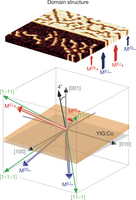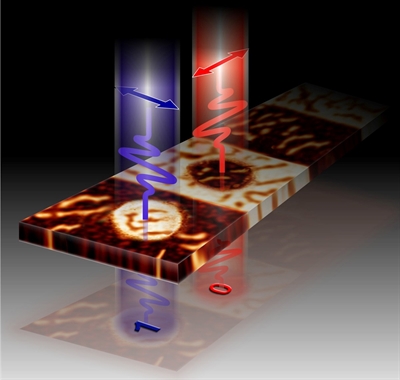R&D: Magnetic Recording With Light and no Heat on Garnet
Ultrafast nonthermal photo-magnetic recording in transparent medium
This is a Press Release edited by StorageNewsletter.com on January 27, 2017 at 2:41 pmFrom Radboud University
A strong short light pulse can record data on a magnetic layer of yttrium iron garnet doped with Co-ions.

This was discovered by researchers from Radboud University in the Netherlands and Bialystok University in Poland. The novel mechanism outperforms existing alternatives allowing ever fastest write-read magnetic recording accompanied by unprecedentedly low heat load, the scientific magazine Nature reports on January 18 2017.
Reliable, cheap and quick data recording will be as crucial to 21st century economics as oil was to that of the 20th century. Magnetic recording performs rather well in that respect, but data centres are getting overheated due to the sharp rise in demand of cloud storage – think of all our Facebook and WhatsApp traffic. A lot of energy is needed to cool their processors. Heat Assisted Magnetic Recording or HAMR, the latest innovation in magnetic recording, will not solve this problem. On the contrary: it uses the heat of a laser pulse to speed up the recording process. For this reason, super-fast magnetic recording that produces no heat and does not need electromagnets is the holy grail of current fundamental and applied research on magnetism.
Facebook has built its new datacentre in the North of Sweden
to save cooling costs.
Exotic idea does work
Researchers from Radboud University have been experimenting with ways to use the energy of a light pulse to manipulate magnets for more than a decade. Professor Theo Rasing and his colleagues published their first results in a 2007 article in the international journal Science.
The problem with their initial findings was that the mechanism of the recording relied on laser-induced heating that reached temperatures close to the so called Curie temperature, above which the magnetic order is destroyed. The recording via heating and partial destruction of the magnetic order seriously hampered potential applications. Heating negatively affects thermal stability of a recording medium, limits the repetition frequency by the cooling time, and limits the recording density due to heat diffusion.
Spin-orbit interaction
In order to tackle the heating problem, one would need a medium with low optical absorption. For metals with a lot of free electrons, the absorption of light – and thus heating of the material – is unavoidable. It means that in order to reduce the heating, a dielectric material needs to be used. For this study the scientists chose yttrium iron garnet (YIG) – one of the model magnetic dielectrics in fundamental and applied research. It is impossible to record information through light on normal YIG. But to increase its sensitivity to optical excitation, the scientists doped it with Co-ions. Co-ions are known for the strong coupling of magnetic moments to the orbital motion of electron (so-called spin-orbit interaction). Light can effectively change orbital motion of the electrons in the ions and thus affect magnetism. Experiments fully met the expectations of the scientists. They found that in the Co-substituted garnet film, a single linearly polarized femtosecond laser pulse promotes switching of spins between different states.
Cobalt garnet is a glassy, transparent material.
The researchers use small pieces for their experiments.
“By changing the polarization of the laser pulse we deterministically steer the net magnetization in the garnet: we write 0 and 1 magnetic bits at will,” Alexey Kimel, physicist, Radboud University, explains. “This mechanism outperforms existing alternatives, allowing the fastest ever magnetic write-read recording event, lower than twenty pico-seconds, accompanied by unprecedentedly low heat load.”
Kimel had trouble getting funding for this project because his idea was considered too exotic to possibly be true. The publication in Nature proves that he was right from the start.
Applicable in data centres and super computers
Using light for magnetic switching on garnet films will probably not be applied in personal computers. “The technology gap between storing on metal and garnet crystal is too big”, Alexey Kimel thinks. “But it could be an interesting option for the big data warehouses of Google and Facebook and the like. Another possible use could be data recording at very low temperatures. Super conducting electronics and quantum computers lack a fast memory system that can record at temperatures below 10 Kelvin (-263 degrees Celsius). Up until now this was a serious obstacle for super conducting computing.”
Publication:
Ultrafast nonthermal photo-magnetic recording in transparent medium
by A. Stupakiewicz, K. Szerenos, Laboratory of Magnetism, Faculty of Physics, University of Bialystok, 1L Ciolkowskiego, 15-245 Bialystok, Poland, D. Afanasiev, A. Kirilyuk, and A. V. Kimel, Radboud University, Institute for Molecules and Materials, 135 Heyendaalseweg, 6525 AJ Nijmegen, The Netherlands.
















 Subscribe to our free daily newsletter
Subscribe to our free daily newsletter
